Rosetta S. Elkin, tiny taxonomies at the Jardins du Métis Festival (2016)
FIND IT ON THE MAP









Rosetta S. Elkin, tiny taxonomies at the Jardins du Métis Festival (2016)
The practical measures of sustainable design make the landscape function more efficiently and reduce the amount of wasted materials and energy; they are conceived to contribute to the overall health of the planet rather than detract. But without an artistic or cultural component to the landscape, we are creating natural places that function like machines. A truly sustainable place works on a more visceral level. We are transforming places so people will love them, will take better care of them, will want them to flourish for their grandchildren and their grandchildren’s grandchildren. If we just look at what are called “best practices,” meaning the technologies that are accepted as most environmentally healthful, we still would not necessarily know how to make a landscape that people will internalize, make their own. Sustainability is about people taking ownership, learning how to sustain, rather than abuse or just consume, the landscape. It is about making clear the connection between human practices and our environment.
The field of landscape architecture can make these connections between humans and our environment.
Joao Ferreira Nunes + Proap, Alcantara Wastewater Treatment Plant (2011)
The concept of ecological restoration, as developed over the past twenty years, rests on the mistaken assumption that we can somehow bring back past ecosystems by removing invasive species and replanting native species. This overly simplistic view of the world ignores two basic tenets of modern ecology-that environmental stability is an illusion, and that an unpredictable future belongs to the best adapted.
Many landscape architects feel conflicted by the restoration debate, trapped between the profession’s idealistic rhetoric about the innate superiority of native ecosystems and the constraints imposed by the financial and ecological realities of a particular site. Over the past 250 years, people have altered the basic trajectory of modern ecology to such an extent that going back to some earlier native condition is no longer possible and is certainly not a realistic solution to the increasingly complex environmental problems that we face.
Landscape architects-and anyone else who works directly with vegetation-need to acknowledge that a wide variety of so-called novel or emergent ecosystems are developing before our eyes. They are the product of the interacting forces of urbanization, globalization, and climate change, and are made up of organisms that have been brought together by the elimination or neutralization of barriers that had kept them separated for millions of years. The concept of a novel ecosystem applies not only our cities and suburbs but also to many landscapes that have been subjected to the disturbance-intensive practices of agriculture, industry and mining. It is unrealistic to assume that turning back the ecological clock will be any easier than turning back the economic clock that created these landscapes.
Landscape architecture can be a charged discipline, especially when it has to resolve the competing interests of its human clients with those of the other organisms that seek to inhabit the same space. The dichotomies that separate people from nature, and native from non-native species, present problematic contradictions that landscape architects must resolve if they hope to have a lasting impact on the environments they design. All of which brings me to the main purpose of this essay: to articulate an ecologically oriented vision for human-dominated landscapes that does not define them as intrinsically negative, valueless, or alien.
(…)
Urban landscapes can be divided into three broad categories based on their soils, their land-use history, the vegetation they support and, by extension, their maintenance requirements. The first type is the remnant native landscape that consists primarily of native plants growing in relatively undisturbed native soils. Given a consistent level of maintenance, they can be preserved as features within the urban context; without maintenance, they are often overwhelmed by non-native species. Second are the managed, functional landscapes, including gardens, parks, ball fields, cemeteries, etc. These are dominated by cultivated plants, with rich manufactured soils, and they have medium-to-high maintenance requirements. And finally there are the ruderal or abandoned landscapes -the least studied of the three types and the focus of the remainder of this essay. These consist of post-industrial or post-residential vacant land, and infrastructure edges dominated by spontaneous vegetation, either native or introduced, on relatively poor and often compacted soils. They have extremely low maintenance requirements-so low in fact that they can be considered self-sustaining.
One important research question concerning ruderal landscapes is how much land in any given city does spontaneous vegetation occupy. With the help of my Harvard Graduate School of Design students using GIS technology, we calculated that roughly 9.5 percent of the surface area of Somerville, Massachusetts (one of the most densely populated cities in the state) is dominated by spontaneous vegetation. This is land that no one maintains, and it exceeds the land area occupied by maintained parks.
In Detroit, roughly 40 percent of the total land area has been abandoned -a remarkable figure, equivalent to the total area of the city of Boston. Some of this land consists of abandoned buildings, but about half can be classified as open space. While Detroit is clearly a tragic story from the socioeconomic perspective, it is a paradise for spontaneous vegetation. In a typical residential Detroit neighborhood, not more than a mile from downtown, perhaps only one in five or ten houses are left standing, while the others have been torn down and hauled away. The remaining compacted subsoil may or may not have fresh topsoil and grass seed spread on top of it. Orchard grass (Daclylis glomerata) and a variety of other European grasses quickly get established and create a remarkably pastoral-feeling landscape. In areas where this grass is not mowed, trees, shrubs, and vines move in and, given enough time, develop into forests.
Peter del Tredici, The Flora of the Future (2014)







The city is a landscape; its soils and geology define its fundamental character. Our work and interests stem from understanding time and territory, the geology and wider landscape patterns, the river catchment with propositions for water sensitive urban design, the urban forest with how liveable the city is and how resilient the urban dweller feels. Our work ranges from strategic planning to forensic analysis of the below-ground condition, considering the soil’s biological complexity and its capacity for yield and absorption. Collaborations enable our practice to reach widely into the marginal territories that inform our work; the poetry and science of soils; the sound of geology; the value of shared grass roots knowledge; the biomimetics of spider sheet webs. Our profession concerns that which makes land a landscape, the people who inhabit it and the resilience of the environment and the individual that together create city communities in all their density and diversity. We seek an archaeological narrative and creative ways of how to stimulate the stewardship of the city’s natural capital.
Johanna Gibbons, Interview (2015)








Johanna Gibbons & J+L Gibbons + Muf Architecture – Art, Dalston Eastern Curve Gardens (2009)
Long-term sustainability necessitates an inherent and essential capacity for resilience – the ability to recover from disturbance, to accommodate change, and to function in a state of health. In this sense, sustainability typically means the dynamic balance between social-cultural, economic and ecological domains of human behavior necessary for humankind’s long-term surviving and thriving. As such, long-term sustainability sits squarely in the domain of human intention and activity – and thus – design; it should not be confused with the ultimately impossible realm of managing “the environment” as an object separate from human action. Instead, the challenge of sustainability is very much one for design, and specifically, design for resilience.
A growing response to the increasing prevalence of major storm events has been the development of political rhetoric around the need for long-term sustainability, and in particular, its prerequisite of resilience in the face of vulnerability. As an emerging policy concept, resilience refers generally to the ability of an ecosystem to with- stand and absorb change to prevailing environmental conditions; in an empirical sense, resilience is the amount of change or disruption an ecosystem can absorb and, following these change events, return to a recognizable steady state in which the system retains most of its structures, functions and feedbacks. In both contexts, resilience is a well-established concept in complex ecological systems research, with a history in resource management, governance and strategic planning. Yet despite more than two decades of this research, the development of policy strategies and design applications related to resilience is relatively recent. While there was a significant political call for (implied) resilience planning following New York’s Superstorm Sandy in 2011 and the ice storm of 2013 in Toronto and the North- Eastern US, there is still a widespread lack of coordinated governance, established benchmarks, implemented policy applications, tangible design strategies, and few (if any) empirical measures of success related to climate change adaptation. There has been too little critical analysis and reflection on the need to understand, unpack and cultivate resilience beyond the rhetoric and to develop specific tactics for design. Design for resilience would benefit from an evidence-based approach that contributes to adaptive and ecologically responsive design in the face of complexity, uncertainty and vulnerability. Put simply: What does a resilient world look like, how does it behave and how do we design for resilience?
Nina-Marie Lister, Resilience. Designing the new sustainability (2015)
Landslag, Anti Avalanche structure for Siglufjördur (2011)
Landscapes often contain and are subject to natural processes that change the designer’s original plan. There are also landscape designers who intentionally seek to obscure the human act of design. These concerns deepened with the development of modern landscape architecture in the twentieth century. Borrowing many of its tenets from modern architecture, which distrusted allusion and stressed honesty of expression and truth of materials, modern landscape architects considered how their work could be a true evocation of modern times. This thinking is evident in the writing by one of its earliest proponents, Christopher Tunnard. For Tunnard, gardens and landscapes that appeared to be the act of natural processes were not only old fashioned, but also deceiving. In his appraisal of the work of Swedish Garden Architects at the First International Congress of Garden Architects in Paris in 1937, he chided this Association for clinging to a romantic conception of nature when they suggested that planting should ‘give the impression that they have grown there spontaneously’. Tunnard cautioned, ‘the imitation of nature is a long perpetuated fraud’.
also see: Messy Ecosystems

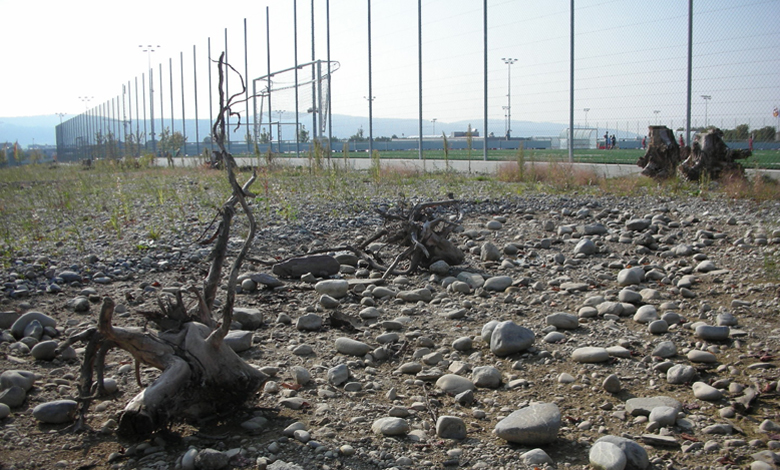
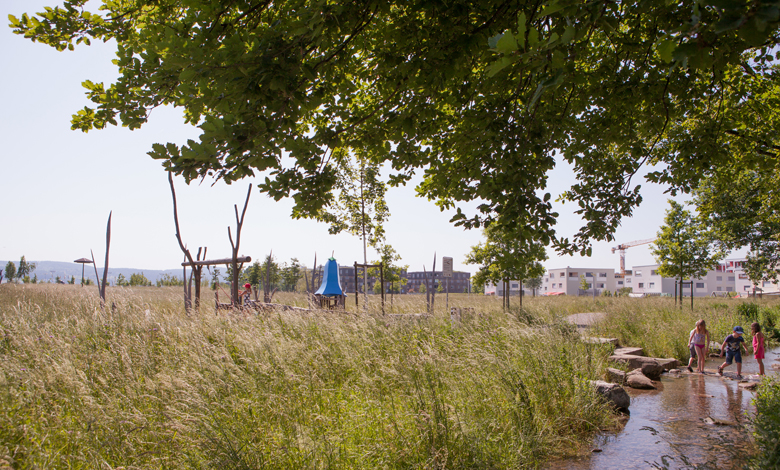
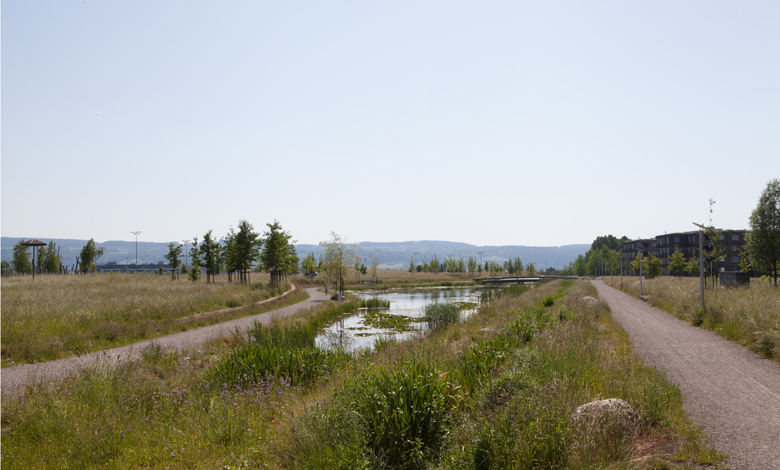
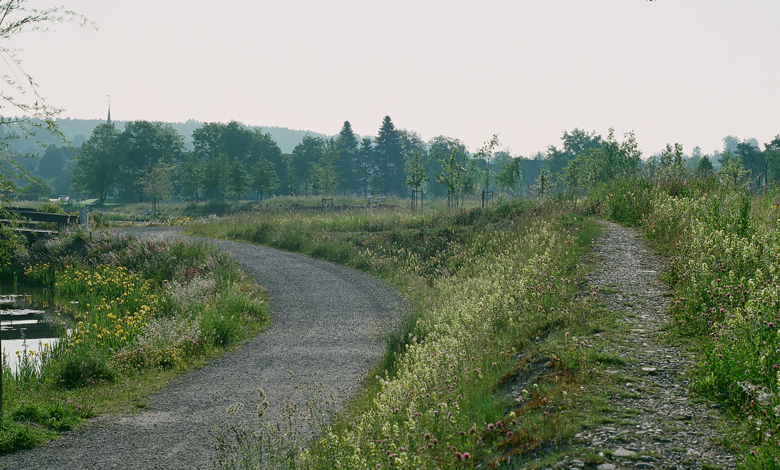
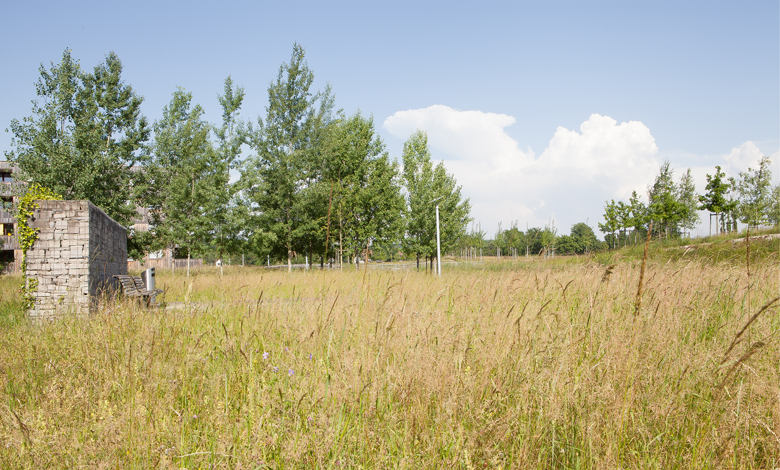
ASP Landscape Architects, VolketswilGriespark (2009)
Parks are not the answer. Not for impoverished cities plagued with socio-economic crises that are painfully embodied in immense tracts of land abandoned by defunct industries and antiquated infrastructure. The question is: what if reframing formerly urban fallow sites as fertile ground for regeneration constitutes a means for a city to reinvent itself? When traditional redevelopment under-delivers or fails to materialize, as it often does in times of fiscal distress, can landscape architects offer resourceful design strategies that require a new way of seeing and a fresh vocabulary?
The term ‘wildland’ posited here attempts to brand cultivated urban wilds along with other unconventional landscape- based tactics to fill the gaps and dispel the stigma of disinvestment. Can wildland assume a role as healthy urban fabric, no lesser an asset than parkland? For well over a decade, notable examples in Germany invented ‘urban nature parks’ promoted by progressive planning policies to convert fallow land into productive resources for the current and future city. Yet American municipalities default to mowed lawns to keep blight at bay, albeit at a great cost. The unfortunate urge to tame urban wilds denies the reality of urban entropy and sacrifices the socio-ecological benefits that citizens could harvest from a landscape with a savage tenacity.
Julie Bargmann, Why not Wild? (2012)
GTL Gnüchtel Triebswetter Landschaftsarchitekten, Old Niddawiesen Airfield (2004)
Olmsted employed the term pastoral instead of the beautiful or picturesque to evoke a familiar, tranquil, and cultivated nature as a counterpoint to the city. Olmsted’s pastoral wove together the precepts of eighteenth-century landscape theory and Jeffersonian agrarianism.
Even more than Downing, Olmsted regarded the landscape as an instrument of social order. Gently undulating grass, serpentine lakes, sinuous pathways, and leafy woodland groves provided urban dwellers a much-sought-after alternative to the dense industrial city, presumably with salutary moral as well as physical effects. Not intended as a zone of active use, the pastoral public park presented composed scenery for passive viewing. The purpose of this engagement Olmsted described with typical zeal: “No one who has closely observed the conduct of people who visit Central Park can doubt it exercises a distinctly harmonizing and refining influence upon the most unfortunate and lawless of the city —an influence favorable to courtesy, self-control, and temperance.”
Urban dwellers proved much more resistant to “harmonizing” than Olmsted expected, and in the face of American pluralism, public parks became more diverse in their activities and accommodations. Nevertheless, as reiterations of Central Park appeared in cities large and small across the United States by the beginning of the twentieth century, the enveloping pastoral aesthetic of the public park prevailed and carried with it the equation of pastoral scenery and ameliorative social influence.
Louise Mozingo, Pastoral Capitalism (2011)

Frank Leslie, The Central Park. A delightful resort for the toil-worn New Yorkers (1869)
Header: Frederick Law Olmsted + Calvert Vaux, Map of Central Park, New York City (1868)
It is always a bit of a dilemma to write about the landscape’s role in sustainability. How do we sound relevant when our basic training and ethos have been conjoined to the ideal of sustainability even before the word ‘sustainable’ became common parlance? Learning how to site buildings so they sit softly upon the landscape and operate passively to conserve and generate heat; to shelter them from winds; to control and harness water and protect a site’s permeability; to create and protect habitat and encourage bio-diversity; to use plants to remediate and modify climate conditions; and to create beauty are what we learn and teach at school. As landscape architects, learning to design with “green” in mind is core to what we do as a profession.
So how does “ecological urbanism” expand the core values to a profession that is essentially focused on the role of the landscape- a field whose basic ethos is to work within an ecological framework? How does this really differ from basic training?
Martha Schwartz, Ecological Urbanism and the Landscape (2009)
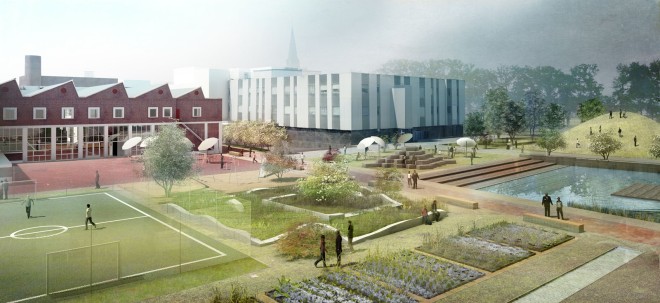

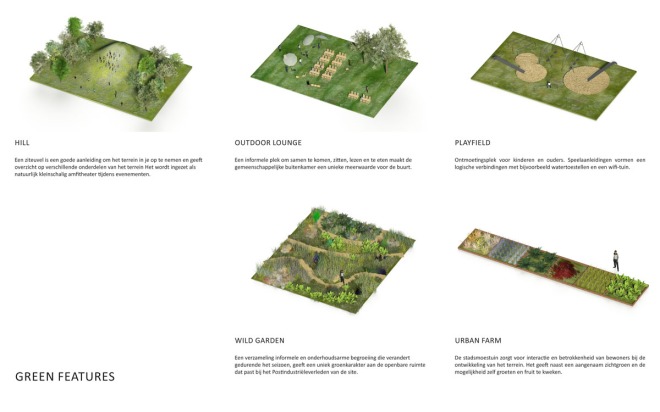






Rients Dijkstra + MAXWAN + MASA architects, Instant Utopia (2012)
Five years ago I became a guerrilla gardener. I stepped out into the world to cultivate land wherever I liked. The mission was to fight the miserable public flowerbeds around my neighborhood. Until then I had always lived, more or less, on the right side of the law.`I had recently moved to a high-rise flat on a bleak roundabout in south London – an area notorious for its labyrinth of pedestrian underpasses, garish pink shopping centre and traffic volumes to rival Britain’s busiest motorways. It is the kind of environment that drives people to crime. My crime was gardening on public land without permission and battling whatever was in the way.
Even when one has permission, cultivating a garden is always a fight. We cut back one plant to allow another one to flourish; we scatter seeds, but we rip up weeds and snatch away flowers and fruit before their seed has dispersed. Our gardens are scenes of savage destruction. “Animals uproot, frosts cripple, winds topple, rains flood. The guerrilla gardener shares this constant battle with nature with other gardeners. But we have other enemies and ambitions.
This handbook has been compiled from my experience of guerrilla gardening and that of guerrilla gardeners around the world. Radical and reticent, active and retired, successes and failures – they have all shaped these pages. I have also drawn on the documented advice of ‘conventional’ guerrillas, whose analysis of strategies and tactics can be applicable to our fight. The debate and instruction goes well beyond gardening. To succeed a guerrilla gardener needs to know more. Do not be daunted: read on.
Richard Reynolds, On Guerrilla Gardening (2009)
Kenneth Weikal, Lafayette Greens (2011)
(Header: Richard Reynolds at work)